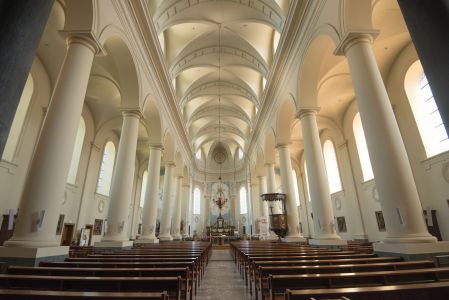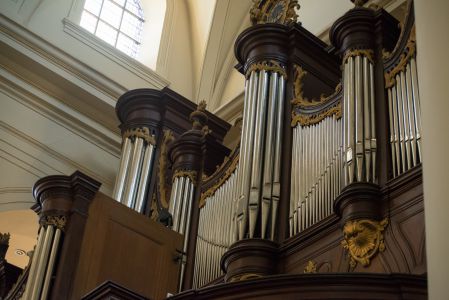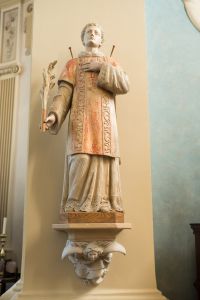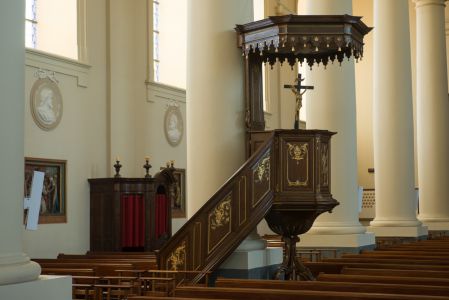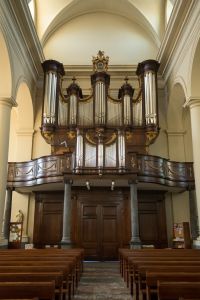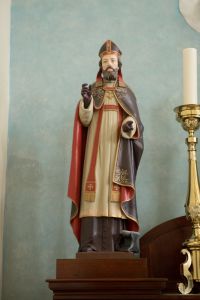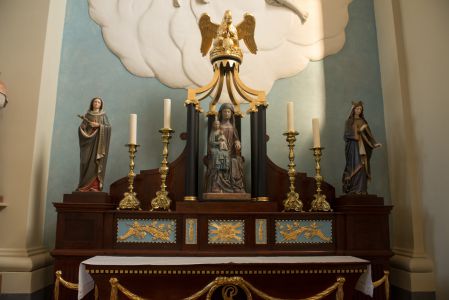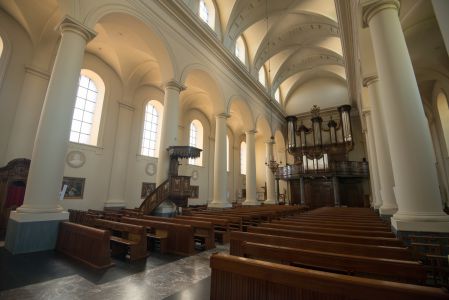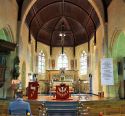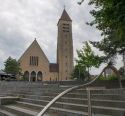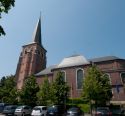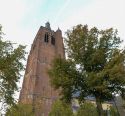Church | 1785-1788 | Classical | Catholic Church




Map
Opening hours
01 January - 31 December
Mon 9.00 - 17.00
Tue 9.00 - 17.00
Wed 9.00 - 17.00
Thu 9.00 - 17.00
Fri 9.00 - 17.00
Sat 9.00 - 17.00
Sun 9.00 - 17.00
Guided tour
Religious offices
Description
The Abbess of Herkenrode, near Hasselt, undertook the building of a new church in 1785.It was named after Saint Quintin and completed in 1788.The early Gothic low tower from the 13th century has been preserved at the side of the church. The west façade still shows traces of two earlier churches.
In 1949, the tower, the Romanesque baptismal fonts in the chapel tower (12th century) and the façade were classified as monuments. The whole church and the town hall were protected as historical monuments in 1983.
Inside one notes immediately the monumental organ, originally a Robustelly, which came from the Cistercian abbey at Val-Saint-Lambert. Besides that, it is the whole classical interior and the dozen Tuscan columns which impresses by its splendour.
Since the church’s interior renovation in 2009, the stucco ornamentation of the choir and the side naves (1789 André-Martin Vivroux) impress by their beauty and grandeur. These works of art depict the Trinity, the Ascension and the Assumption.
Other valuable works include the 14th century “Sedes Sapientiae” in walnut from the Meuse area, a wooden statue of Virgin and Child with Saint Anne from 1500 from Brabant, a stucco Way of the Cross (1904) by A De Beule of Ghent and a 1765 pulpit from Liege.
Photos
Media
Remarkable elements
High altar
The former main altar is built in Louis XV style. Grain and grape motifs represent bread and wine. Above the tabernacle stands a decorative altar throne with a curved sliding door with bas-relief. All the elements are fused to a whole with the altar cross (late 18th century) on a pedestal. The altar Angels (c. 1800) fold hands in worship or invite to respect and prayer.Statue
This statue of walnut is from Maasland origin and dates back to the 14th century. It shows traces of the original polychromy. Mary's womb is seen as a seat on which Jesus, the eternal Wisdom, sits enthroned. In the 13th and 14th century, particularly the Maas region created statues of the Sedes Sapientiae. This seated Madonna-with-child was - perhaps under Spanish influence – planed; to make it possible to hang magnificent gowns (specific to that time) over the statue in a better way.Baptismal font
Baptismal font in Romanesque style from the 12th century. It possibly refers to the baptism privilege granted by the parish Hasselt to her side parish Zonhoven in the 11th-12th century and to the existence of a first church on this site. The inverted satyr heads represent the victory over the devil symbolicly. Inscription on the bottom: "Restored during the war, when Coenegracht was pastor in 1916." Cover: cast metal – Willy Ceyssens, Hechtel 1973.Stucco work
The classicists of the 18th century paid much attention to the lighting and the decoration of the interior of churches. This also reveals itself in many large windows and frequent stucco in the St. Quintinus church. The scene in the choir (1789) depicts the Holy Trinity and is made by André Martin Vivroux (Liège ° 1751 -+ 1817). The setting, draping and gestures are typical of his style. Above the side altars also hang two creations of his hand (the Ascension of Christ and the Assumption of Mary).Pulpit
The pulpit – which probably comes from the early church - is dated on the back: 1765. During previous restoration work of the interior in 1965, it was removed from the church. For a long time the different parts were stored in the municipal warehouses and in the old town hall. Since the renovation in 2009 the pulpit is restored to its former glory and it adorns its familiar place again.Orgel
The organ was built in the 17th century (1664) by Pascal Limbourg for the Cistercian abbey of Val St. Lambert (Liège). He used material derived from the organ of the St. John's Church in Utrecht (built by Peter Janszoon de Swart in 1573). In 1761 the Dutch organ was converted in Val St. Lambert, by the famous organ builder Guillaume Robustelly who is also the designer of the current organ case. Around 1820, the instrument was transferred to Zonhoven. In 1959 Emile Verschueren from Tongeren modernized it to the compulsory standards of that time.
Organ builder Marc Nagels meticulously renovated the organ in 2012.
The organ has 40 stopknobs, 2446 pipes and allows music from any style period. The present instrument still contains 5 original registers of the original disposition from 1664. It is one of the most beautiful and largest organs in Limburg.


